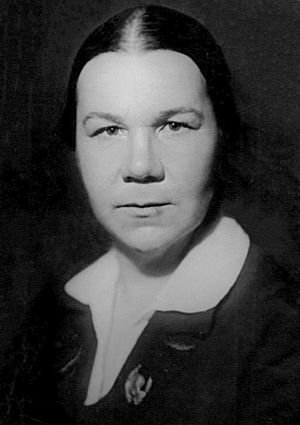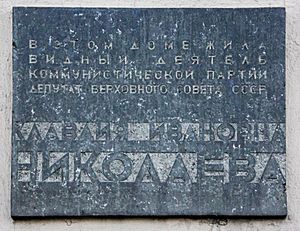Klavdiya Nikolayeva facts for kids
Quick facts for kids
Klavdiya Nikolayeva
|
|
|---|---|
| Клавдия Ивановна Николаева | |

Klavdiya Nikolayeva in 1938
|
|
| Personal details | |
| Born | 13 June 1893 Saint Petersburg, Russian Empire |
| Died | 17 December 1944 (aged 51) Moscow, Russian SFSR, Soviet Union |
| Nationality | |
| Political party | RSDLP (Bolsheviks) (1909–1918) Russian Communist Party (1918–1944) |
| Occupation | trade unionist, writer, editor, politician |
Klavdiya Ivanovna Nikolayeva (Russian: Клавдия Ивановна Николаева; 13 June 1893 – 28 December 1944) was an important figure in Russian history. She was a revolutionary who wanted big changes in society. She also worked for workers' rights and was a feminist, meaning she believed in equal rights for women. She was a politician in the Soviet Union.
Contents
Early Life and Activism
Klavdiya was born in Saint Petersburg. Her father was a worker, and her mother was a laundress. She started working as a nanny when she was very young.
After finishing elementary school, she worked at a printing press. This is where she began her activism. She wrote for a journal called Rabotnitsa, which means Working Woman.
Klavdiya was first arrested in 1908 when she was 15 years old. The government at the time, called the tsarist authorities, arrested her three more times. She was also sent away from her home twice.
Joining the Bolsheviks
In 1909, Klavdiya joined the Russian Social Democratic Labour Party (RSDLP). She became a member of the Bolsheviks, a group that wanted to change Russia's government.
She also worked with the printing union. This union helped workers in the printing industry. While she was sent away to a village called Kazatchinskoe, she led the local RSDLP group there.
A Leader in the Revolution
After the February Revolution, Klavdiya went back to Petrograd (which is now Saint Petersburg). She became the editor of Rabotnitsa again. This journal was very important for helping women get involved with the Bolshevik Party.
She also took part in the October Revolution. This was a major event that changed Russia's government. From 1918, she led the women's section of the Communist Party of the Soviet Union (CPSU) in Petrograd. She also managed their department for spreading ideas and information.
Klavdiya led the First Conference of Working Women. In 1924, she became the head of the Zhenotdel. This was the women's department of the Communist Party's main office. She took over after other important women like Alexandra Kollontai.
She supported a group called the United Opposition. This group had different ideas from Stalin. Because of this, she lost her job at the Zhenotdel. However, she continued to be active in the party.
In 1928, she led the department for spreading ideas in the North Caucasus. From 1930 to 1933, she was part of a special group that organized the Communist Party's activities. She led the department for campaigns that involved many people.
Later, she became a deputy secretary for party groups in West Siberian Krai (1933) and Ivanovo Oblast. From 1936, she was a secretary for the Central Trade Union Council.
Klavdiya was a member of the Communist Party's main committee from 1924 to 1925. From 1934, she was part of the Central Executive Committee of the Soviet Union. She was also a member of the Supreme Soviet from 1937 to 1944. From 1938 to 1944, she was part of the Supreme Soviet's leadership group.
World War II Contributions
During the Second World War, Klavdiya helped organize many important things. She arranged training for nurses and health workers. She also helped move children to safer places.
She helped professional unions support Red Army units. She also helped organize places for paramedics.
Once, while returning from a trip to the United Kingdom, her ship was attacked by German forces. Klavdiya helped rescue those who were hurt.
Klavdiya Nikolayeva passed away on 28 December 1944. She received the Order of Lenin and other awards for her work. Her ashes are kept in the Kremlin Wall Necropolis in Red Square in Moscow.

Works
Besides her articles in The Worker, Klavdiya Nikolayeva wrote two books. These books were about how women helped build and defend the Soviet Union:
- The Communist Party and the action among women (1925)
- The Great Patriotic War and the Soviet Woman (1941)

